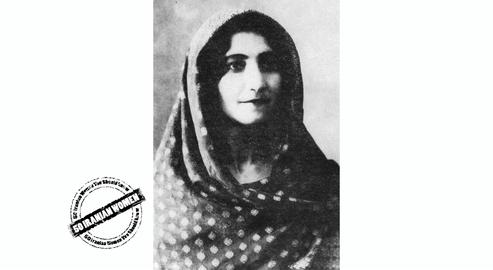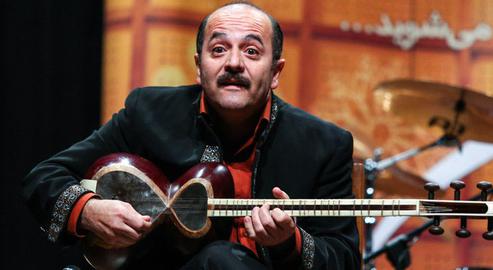The following article was written by an Iranian citizen journalist on the ground inside the country, who writes under a pseudonym to protect her identity.
The only remaining picture of Varto Terian, Iran’s first theater actress, is a black-and-white portrait of her wearing a large patterned headscarf. Though she is no longer a household name, for many, Terian will be remembered for her contributions to the stage, and for opening the way for many others after her.
In 1921, Terian and her young daughter appeared on stage in a play called Adam and Eve to raise funds for a literacy school for women. Religious zealots prevented the second act going ahead, and for a long time after the performance, Varto Terian faced harassment. But she was more than a match for religious bigots and she refused to be driven offstage.
Modern theater first came to Iran in 1885, when a playhouse was built in a corner of Dar ul-Funun, the first modern school for higher education in Iran, established in 1851. Mirza Ali Akbar Naghash Bashi, one of the first Iranians to go to Paris to receive a western education, founded the theater. A French music teacher at the school called Monsieur Lumaire assisted him in running it.
At this time, theater was neither for the public nor for women. It was for the shah, his courtiers, and for aristocrats. Iranian women were not only denied an education but they could not even leave home without the permission of their male guardians or husbands. As with Ta’zieh, traditional Shia passion plays, or in plays in early modern Europe, boys took on the parts of women.
Despite these restrictions, the playhouse planted the seeds of modern theater in Iran, which expanded after the 1906 Constitutional Revolution and the return of more western-educated Iranians from Europe. Still, not only could women not appear on stage, they were not even allowed into theaters.
Varto Terian was born in 1896 to an Armenian family in the Iranian Azerbaijani capital of Tabriz [now East Azerbaijan]. She was still a child when her family moved to Tehran. After finishing high school, she was sent to Switzerland and studied literature, elocution and acting. Her return to Iran coincided with the founding of a number of theater companies in Tehran, including the Young Armenians Theater Society. At that time, Armenians were more liberal than the surrounding Muslim society. They did not have the same taboos around mixing genders in schools or at gatherings, provided it was not done in a public space. It was at a theater society meeting that Varto came to know her future husband, Arto Terian.
Born in 1892, Arto Terian was also an Armenian who had studied at the same Armenian school in Tehran as Varto had. He had also studied in Tsarist Russia, where he learned about theater and became passionate about it. After their marriage, Varto Terian launched her career on stage.
A Real Woman, Not a Boy!
In 1921, Arto Terian joined a theater company set up by a group of educated young Iranians, including the scholar, writer and poet Saeed Nafisi and future director Gholam Ali Fekri Ershad.
Together, they staged a romantic play directed by Arto. He gave the lead role to his wife — despite women being still banned from theater. The news that a woman, and not a boy dressed up as a woman, was appearing on stage drew in large audiences, as did praise for Varto Terian’s performance, which quickly circulated throughout Tehran.
The play’s success encouraged the company to take it on road. It was well received in the northern city of Rasht and the Caspian Sea port of Bandar Anzali. But the ramparts of a traditional society were not so easily conquered. To protect her family from harassment, Varto chose the stage name of “La La” instead of using her real name.
After this success and that of a second play, the couple joined the Young Iran Society, which was founded by European-educated Iranians led by Abdolhossein Teymourtash. As the court minister to Reza Shah, the first king of the Pahlavi dynasty, Teymourtash was to play an important role in modernizing reforms in Iran. At the time when most public spaces were closed to them, women were allowed to freely frequent the grounds of the Young Iran Society. It became a magnet for Iranian female artists, including Qamar-ol-Moluk Vaziri, the first Iranian woman to sing in public.
As in many parts of the world, Iran in 1921 was an exciting time in terms of culture and progressive politics. As part of this, a number of women founded the Society of Patriotic Women, which aimed to promote women’s rights and above all the right to an education. These female activists successfully launched several schools for girls in Tehran throughout the 1920s, but they did not stop there. They wanted to create schools for adult women who had never had a chance to study — and at the time, this meant the majority of women. To this end, they needed capital.
One of the society’s members suggested staging a play for women to raise funds, as well as to provide entertainment. Society member Noor ul-Hoda Mangeneh had a big house with a large pool in the middle of its grounds that could be covered and converted into a stage — a traditional venue for private shows and music. The Society of Patriotic Women knew about Varto Terian, and wanted her to direct and perform in Adam and Eve at their impromptu theater. This time, they decided, they would turn a theatrical norm on its head: Instead of boys playing women, women would play men.
Notices were printed in the format of wedding invitations and society members distributed them among family and friends. The date was set for a night in 1929 during the holy month of Ramadan, because during this month women were allowed to be out at night, ostensibly to participate in religious and prayer gatherings with other women. Each women was to bring an oil lamp or a lantern to light up the stage. On the night, between 300 to 500 women wrapped in black chadors came to see the play.
The first act went well. Refreshments were being served during the intermission when there was a loud bang on the door and police officers rushed in. A number of women tried to escape by climbing over the rooftops. The organizers had considered the possibility that religious zealots might intervene, and had prepared a couple to assume the roles of “bride and groom” so the facade of a wedding could be upheld. But someone had informed the police about what was going on, and the tactic did not fool them.
Playing the “Other” Woman
The performance was aborted, but Varto Terian did not give up. One of the most memorable plays she appeared in was Mahpar by Ali Akbar Siassi. Siassi later became education minister, and played an important role in the drafting and enforcement of national compulsory free education.
Siassi’s four-act play was a no-holds-barred attack on the hijab and chador. Gender segregation was still the order of the day: In the hall where the play was staged, women were seated in the balcony, separated off from men.
Varto Terian played the lead role of Mahpar, a beautiful and learned woman whose seemingly modern husband treats her with disdain, although he is very friendly towards the hijab-wearing wives of his friends. One day, Mahpar dresses herself in a chador, covers her face, and “accidentally” runs into her husband and sets out to lure him without him knowing who she is. She succeeds; the husband professes his ardent love and begs her to be with him. The dénouement comes when Mahpar removes her hijab and reveals her face, shaming her husband for ignoring her as his wife but falling in love with her when he thinks she is another woman.
At the time, the story struck a chord with many women, some of whom approached Varto and told her that she had given voice to their frustrations.
Varto Terian was also the first woman to recite Persian poetry on stage and taught French and elocution at Tehran’s Teachers School.
And her little girl, Alenush Terian, grew up to become the first Iranian woman astrophysicist. She founded the Tehran State University of Geophysics and Astrophysics and is regularly referred to as “the mother of modern Iranian astronomy”.
Arto Terian died in 1954 but Varto lived for another 20 years. At the time of her death in 1974 not many remembered her or her contributions to theater and women. So it is important to revive these memories now.
Zohreh Zolghadr, Citizen Journalist
visit the accountability section
In this section of Iran Wire, you can contact the officials and launch your campaign for various problems


























comments